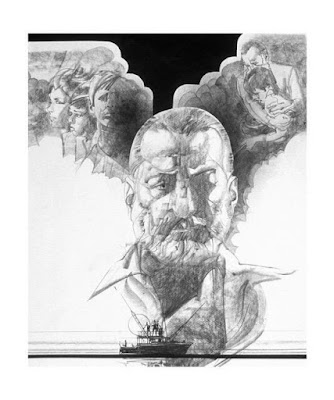
There were three now books that I’d added to my library recently that you might want to check out if you have a fascination with art and illustration.
The Art of Nestor Redondo: When I was first starting to break into the field of comics, their was a Phillipine invasion of extremely talented artists that were also entering the American market, many of them introduced by my former editor at DC, the legendary Joe Orlando. The three names that really stood out for me as the best of this intimidating group were Alex Nino with his bravura style and cinematic storytelling, Tony Dezuniga with a very American ad art sensibility and impeccable draftsmanship and design, and Nestor Redondo. The latter incorporated a wonderful simplicity into an ornate inking style, and the result was always breathtaking and original. And his characters looked like they were drawn by a Western artist, which the editors and publishers, and logically the readers, loved. His work never portrayed a brutality or violence that was in vogue, but instead brought us to a more elegant and refined world. My favorite series by Redondo was “Rima” (based on the “Green Mansions” heroine) which Joe Kubert edited. He and Joe also teamed up on “The Bible” special that DC did.
This book ( 80 pgs. black and white $24.95 soft cover) is packed full of not only Redondo’s comics pages, but lots of pencil studies and rough drawings. Publisher and editor Manuel Auad has brought out another fine addition to his line of illustration books.
Henry Patrick Raleigh, the Confident Illustrator: While poring through Walt Reed’s excellent tomes on the history of illustration in America, I had come across Raleigh’s work, and Arpi Emoyan’s compilation of Hall of Fame Illustrators has a section dedicated to him, but for the most part I was unfamiliar with the artist. Fortunately, this book gives us a much more comprehensive look as his remarkable career. His drawing style has a power and spontaneity that is astounding. There is a stylized sophistication to the characters that parade through his pictures. They are a long, lean and elegant crew of beautiful models, showgirls and debutantes wistfully admired by equally stylish young Romeos. And while this is a very real world, there isn’t a hint of photo reference being used.
In the early twentieth century before the advent of radio, tv and even film, the periodical illustrators of the time were the contemporary pop starts. J.C. Lyendecker was getting ten thousand fan letters a week at the peak of his fame. But despite all of that, any of the NCY galleries would has disdained showing his originals. In the same era, Raleigh’s wife Dorothy put on two major exhibitions of his work in both San Francisco and New York that crossed the lines of fine art and illustration. And that’s just one of the fascinating stories in the biography that is as engrossing as the illustration.
Another Manuel Auad publication. (128 pgs. $34.95 Hardcover)
Click here to visit Auad publications website.
The Drawings of Bob Peak: Long before I knew anything about illustration, I knew who Bob Peak was. His album covers for My Fair Lady, and Camelot had him on my radar since I was a youngster. Like Frank Frazetta and Bob McGinnis I was studying the work long before I started learning about the field in it’s entirety. Bob Peak had a sense of design and color that left you breathless. His work was innovative, spontaneous and mesmerizing. Still, I never thought of his drawing in the same stratosphere as Fawcett, Cornwell, Wyeth, Gibson,etc. This book changed all that.
There is a life, an exuberance, which explodes out of every page of this book. Nothing ever looks calculated. While I have always had a great respect and admiration for Peak’s work, examining this book has taken it to a new level. While we are looking to see the finished statement in illustration, often the working and thinking process reveals something at even a deeper level. The perfect companion to The Art of Bob Peak.
160 pgs. $39.98
Click here to go to Bob Peak's website.
Disclaimer: Some of the drawings used in this blog post were not in the books.



























































